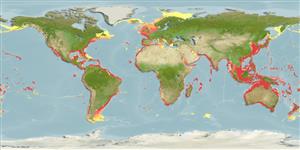Environment: milieu / climate zone / depth range / distribution range
Écologie
marin benthopélagique; océanodrome (Ref. 51243); profondeur 10 - 476 m (Ref. 39327), usually 10 - 100 m (Ref. 2700). Subtropical
Circumglobal: tropical to temperate seas.
Taille / Poids / Âge
Maturity: Lm ? range ? - ? cm
Max length : 61.0 cm TL mâle / non sexé; (Ref. 2850); poids max. publié: 3.2 kg (Ref. 40637)
Épines dorsales (Total) : 0; Rayons mous dorsaux (Total) : 13 - 16; Épines anales: 0; Rayons mous anaux: 11 - 13. Adults dark green, brownish grey, or blue above, white below; juveniles with about 9 bars on back, from eye to dorsal fin; dark spots on front and middle of belly and on side near pectoral base in specimens less than 33 cm (Ref. 4919).
Primarily an oceanic (Ref. 2850, 2683), pelagic species but may enter estuaries (Ref. 4919). Feeds on crustaceans and squids (Ref. 10001). Suspected responsible for fatal poisoning (Ref. 4919). Should not be eaten (Ref. 36731).
Life cycle and mating behavior
Maturité | Reproduction | Frai | Œufs | Fécondité | Larves
Schneider, W., 1990. FAO species identification sheets for fishery purposes. Field guide to the commercial marine resources of the Gulf of Guinea. Prepared and published with the support of the FAO Regional Office for Africa. Rome: FAO. 268 p. (Ref. 2683)
Statut dans la liste rouge de l'IUCN (Ref. 130435: Version 2024-1)
Utilisations par l'homme
Pêcheries: commercial; pêche sportive: oui
Outils
Articles particuliers
Télécharger en XML
Sources Internet
Estimates based on models
Preferred temperature (Ref.
123201): 14 - 28.9, mean 26.1 °C (based on 5858 cells).
Phylogenetic diversity index (Ref.
82804): PD
50 = 0.5005 [Uniqueness, from 0.5 = low to 2.0 = high].
Bayesian length-weight: a=0.01096 (0.00602 - 0.01998), b=2.91 (2.75 - 3.07), in cm total length, based on LWR estimates for this species & (Sub)family-body (Ref.
93245).
Niveau trophique (Ref.
69278): 3.7 ±0.40 se; based on food items.
Résilience (Ref.
120179): Milieu, temps minimum de doublement de population : 1,4 à 4,4 années (Preliminary K or Fecundity.).
Fishing Vulnerability (Ref.
59153): Moderate vulnerability (44 of 100).
Nutrients (Ref.
124155): Calcium = 41 [14, 94] mg/100g; Iron = 0.904 [0.498, 2.058] mg/100g; Protein = 18 [16, 20] %; Omega3 = 0.406 [0.186, 0.815] g/100g; Selenium = 44.2 [23.0, 98.9] μg/100g; VitaminA = 22 [8, 61] μg/100g; Zinc = 0.628 [0.430, 0.889] mg/100g (wet weight);
